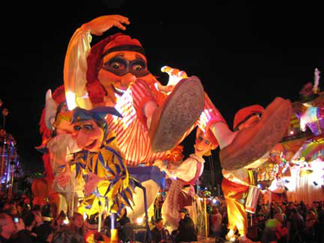
By Stephanie Sommers
The Corso Illuminé is the night parade that circles two times around Place Massena on Tuesday and Saturday nights. I’ve been to two corsos, or corsi, now and they are rather spectacular. There are enormous harlequins and huge floating caricatures of what would have entertained royalty back in the day, a rather fierce dragon (my personal favorite), and various groups of people from various countries who entertain us in between the grotesque processions with acrobatic dances, drum-playing or baton-twirling.
 All of these slowly pass by as the crowd heaves to and fro, filling in the spaces between each float. It is really interesting to see the spectators get up close and personal with the floats, and armed with cans of Silly String (my teacher told me the French call aerosol string cans “les boums,” like bombs) and confetti, they spray the h*** out of the floats, the groups, and each other until literally everybody and everything is covered in string and confetti.
All of these slowly pass by as the crowd heaves to and fro, filling in the spaces between each float. It is really interesting to see the spectators get up close and personal with the floats, and armed with cans of Silly String (my teacher told me the French call aerosol string cans “les boums,” like bombs) and confetti, they spray the h*** out of the floats, the groups, and each other until literally everybody and everything is covered in string and confetti.
Those of us who have chosen not to buy les boums and confetti are frequently targeted with stealth attacks from behind. It’s as if the boumeurs (think bombers) are saying, “Hey, you there, blocking my view and my chance to spray a float, this one’s for you!”
 According to my teacher, Jean-Philip, this is actually much better than the alternative that was employed not so long ago. Years ago (I’m guessing pre-aerosol string days) they threw little plastic balls a bit bigger than bb pellets and which weighed a bit more than bb pellets (I’m guessing) as there were always a few eyes put out and, according to Jean-Philip, a couple of near deaths. As Carnival became increasingly popular with tourists from other countries they finally banned the pellets and switched to paper confetti and the infamous boums.
According to my teacher, Jean-Philip, this is actually much better than the alternative that was employed not so long ago. Years ago (I’m guessing pre-aerosol string days) they threw little plastic balls a bit bigger than bb pellets and which weighed a bit more than bb pellets (I’m guessing) as there were always a few eyes put out and, according to Jean-Philip, a couple of near deaths. As Carnival became increasingly popular with tourists from other countries they finally banned the pellets and switched to paper confetti and the infamous boums.
Enough ranting; I will now move on to the promised carnival trivia. As this year’s theme is King of Masquerades, it is fitting that I mention that the Nice Carnival was mentioned various times in the journals of royal patrons during the Middle Ages. It appears to have been particularly popular with dukes from France and Italy, and in 1889 the Prince of Wales (future Edouard Vll) came to light the procession stake to commence Carnival.
My favorite float, the dragon, is called a “babau” and first appeared as a float in 1882 to honor the tradition of grotesque mythology that is prevalent in most Carnival history. Here is where mythology and Catholicism meld together. Winter carnivals are now thought to be a celebration of the advent of Lent, which is why Mardi Gras (literally “Fat Tuesday”) commemorates the end of the Carnival period and incorporates a huge feast, to get ready for eating meagerly (specifically no meat) for the next 40 days. That is if you were a Catholic in the Middle Ages. Nowadays my Catholic friends usually resolve to give something up like sugar in their coffee or white wine. (Notice I didn’t say all wines.) Another interesting fact; apparently all manner of wild behavior and voluntary madness was allowed during this Carnival period as you would pay penance during Lent. Perhaps this explains the folly of Silly String.

